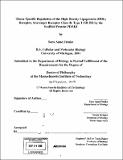| dc.contributor.advisor | Monty Krieger. | en_US |
| dc.contributor.author | Fenske, Sara Anne | en_US |
| dc.contributor.other | Massachusetts Institute of Technology. Dept. of Biology. | en_US |
| dc.date.accessioned | 2009-06-30T16:20:12Z | |
| dc.date.available | 2009-06-30T16:20:12Z | |
| dc.date.issued | 2008 | en_US |
| dc.identifier.uri | http://hdl.handle.net/1721.1/45805 | |
| dc.description | Thesis (Ph. D.)--Massachusetts Institute of Technology, Dept. of Biology, September 2008. | en_US |
| dc.description | Includes bibliographical references. | en_US |
| dc.description.abstract | PDZK1 is a four PDZ-domain containing cytoplasmic adaptor protein that binds the Cterminus of the high-density lipoprotein (HDL) receptor SR-BI. Abolishing PDZK1 expression in PDZK1 knockout (KO) mice leads to a post-transcriptional, tissue-specific decrease in SR-BI protein level and an increase in total plasma cholesterol carried in abnormally-large HDL particles. A greater than 95% decrease in SR-BI expression levels is observed in the livers of PDZK1 KO mice. The mechanism behind this tissue-specific regulation of SR-BI expression is unclear. PDZK1 comprises multiple structural features that, aside from the first PDZ domain, which binds SR-BI, are not known to interact with SR-BI. It seems probable that these structures (three PDZ domains, at least one phosphorylation site on the C- terminal tail, and a putative PDZ-binding motif at its C-terminus) might interact with other cellular components to influence hepatic SR-BI expression. This thesis explores the role of PDZK1's structural features in the PDZK1-dependent regulation of hepatic SR-BI through the hepatic expression of PDZK1 and various truncation and point mutants of PDZK1 in wild-type (WT) and PDZK1 KO mice. These studies demonstrated that overexpression of the first PDZ domain of PDZK1 can affect hepatic SR-BI abundance and localization in both WT and PDZK1 KO mice, but was not sufficient to restore normal SR-BI function in PDZK1 KO mice. Overexpression of the first three domains of PDZK1 in PDZK1 KO mice was able to partially restore cell-surface localization and function of hepatic SR-BI, but was not able to fully restore SR-BI abundance, localization and abundance. | en_US |
| dc.description.abstract | (cont.) Overexpression of full-length PDZK1 or a mutant missing the C-terminal PDZ-binding motif of PDZK1 in PDZK1 KO mice was sufficient to restore normal SR-BI abundance and activity. Therefore, we conclude that some structural feature of PDZK1 between the PDZ3 domain and the C-terminal PDZ-binding motif is required for normal SR-BI expression and. thus, function. It is possible that this feature may be the PDZ4 domain of PDZK1, as preliminary data suggests that overexpression of the four PDZ domains of PDZK1 (missing the C-terminal tail) might be able to fully restore hepatic SR-BI function. | en_US |
| dc.description.statementofresponsibility | by Sara Anne Fenske. | en_US |
| dc.format.extent | 121 p. | en_US |
| dc.language.iso | eng | en_US |
| dc.publisher | Massachusetts Institute of Technology | en_US |
| dc.rights | M.I.T. theses are protected by
copyright. They may be viewed from this source for any purpose, but
reproduction or distribution in any format is prohibited without written
permission. See provided URL for inquiries about permission. | en_US |
| dc.rights.uri | http://dspace.mit.edu/handle/1721.1/7582 | en_US |
| dc.subject | Biology. | en_US |
| dc.title | Tissue specific regulation of the high density lipoprotein (HDL) receptor, scavenger receptor Class B, Type I (SR-BI) by the scaffold protein PDZK1 | en_US |
| dc.type | Thesis | en_US |
| dc.description.degree | Ph.D. | en_US |
| dc.contributor.department | Massachusetts Institute of Technology. Department of Biology | |
| dc.identifier.oclc | 319070409 | en_US |
